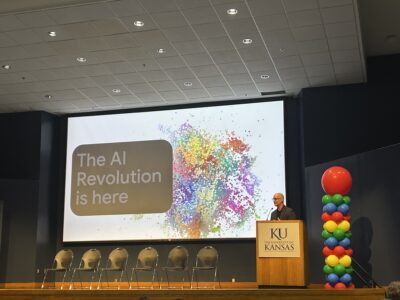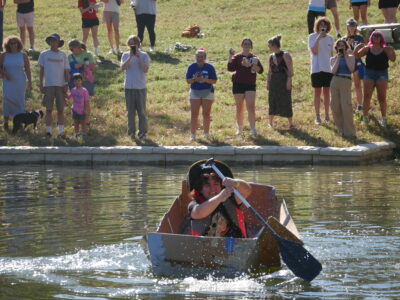KU sets record enrollment for second straight year; total student numbers top the 31K mark

photo by: University of Kansas
The skyline of the University of Kansas is pictured.
UPDATED 11:45 A.M. OCT. 1
Another year, another record.
Overall enrollment at the University of Kansas has hit a new all-time high for the second consecutive year, according to figures released Wednesday by the Kansas Board of Regents.
KU’s overall enrollment increased to 31,169 students, topping by about 400 students the previous all-time high set last year.
“We are pleased to have record-high enrollment for the second straight year and the third-largest freshman class in KU history,” Chancellor Douglas Girod said in a release. “These numbers confirm that talented students see the value of pursuing their education at KU and that, once they arrive here, they receive the support they need to earn their degrees in a timely fashion.”
The growth in students is occurring at both the Lawrence campus and the KU Medical Center in Kansas City, the numbers show. Enrollment on the main campus — which also includes KU’s Edwards Campus in Johnson County — grew by 1.2% to 27,212 students. Enrollment at the Medical Center grew by 1.9% to 3,957 students. KU officials said both campuses set new all-time highs for student numbers.
This is the second consecutive year that KU has set a new overall enrollment mark, but the university got there in a slightly different way this year. Last year, KU’s largest freshman class in history propelled KU to a new high. This year’s freshman class actually was smaller than last year’s class, however, it was still large by historical standards. It was the third-largest freshman class in KU history, and it was significantly larger than last year’s graduating senior class, which allowed overall enrollment to grow.
That smaller freshman class, though, provided a glimpse at the challenges ahead. In a message to university faculty and staff, Girod congratulated and thanked them for their efforts to serve students and grow enrollment. But he also reminded them that the entire higher education industry is expected to face challenges related to significantly smaller high school graduating classes in the near future.
Known in the industry as the “demographic cliff,” universities are expected to soon start competing for fewer graduating seniors. The demographic shift started in 2008 during the Great Recession. Facing financial strains, families began having fewer children. Now — nearly 18 years later — those lower birthrates are starting to show up in smaller graduating high school classes.
“It is appropriate to pause and celebrate this year’s record-setting enrollment, but we must maintain focus on the work ahead,” Girod told faculty and staff in his Wednesday message. “Higher education faces unprecedented challenges, including a projected national decline in enrollment in the coming years. Despite these headwinds, there are opportunities for universities that continue to be proactive and intentional.”
Heading into the demographic cliff, KU has been one of the more successful universities in the state at growing its enrollment. Wichita State and KU have posted the top growth rates for both the last five years and 10 years, far outpacing the four other public universities in the state.
KU’s growth curve, however, showed signs of cracking this year. While it set an overall record in enrollment, the pace at which it added new students slowed significantly. For example, while the main campus added about 325 students this year, it added about 1,400 last year and about 1,600 the year before.
KU’s growth rate of 1.2% on its main campus actually was fourth among the six Regents universities in the state.
Here’s a look at enrollment totals for the six Regents schools, and their one-year growth rates.
• KU: 27,212 students, up 1.2%
• Kansas State: 20,719, up 4.6%
• Wichita State: 18,458, up 4.3%
• Fort Hays State: 12,849, down 0.2%
• Pittsburg State: 5,803, up 0.5%
• Emporia State: 4,820, up 5.8%
KU relies on out-of-state students to a greater degree than other public universities in Kansas, and some of KU’s historical recruiting grounds faces some of the steepest drops in high school graduating classes. For instance, KU’s pipeline to the Chicago metro area may become smaller in the future. By 2041, Illinois is expected to have a 32% decline in high school graduates, one of the largest declines in the nation.
KU leaders have seen the trend coming for years and have changed some recruiting territories and also have revamped the type of scholarship packages the university offers. But KU officials also embarked on a multi-year effort to boost advising services and other student success efforts as part of a strategy to reduce the number of students dropping out of the university. Reducing the drop-out rate is another way to boost enrollment, and KU on Wednesday touted new records in that area too.
KU had 87.5% of last year’s freshmen return to school this year. That was the highest freshmen retention rate in the school’s history. The school also posted new highs in the percentage of students who graduated in four to six years. KU had a four-year graduation rate of 56.9% and a six-year graduation rate of 70.3%.
“The number of freshmen is the metric that often receives attention this time of year, but equally important to overall enrollment is ensuring that we retain and support existing students as they progress toward their degrees,” Girod said. “We are proud to have again achieved record-setting retention and graduation rates, which are the direct result of our ongoing commitment to supporting students through teaching, advising and other key areas.”
The advising and retention strategy is one that the Kansas Board of Regents — the state board that oversees public higher education — has been pushing for all of its universities. The enrollment numbers released for the entire statewide, public higher education system gave Regents an indication that the system was on the right track, Regents Chair Blake Benson said.
“The Kansas public higher education system has now experienced three consecutive years of fall enrollment growth,” Benson said in a release. “This is an encouraging trend and a sign that our system is providing affordable and accessible educational options for families. Our colleges and universities will continue to implement promising practices that help Kansans advance their education and careers and to work with businesses to build a robust talent pipeline for our state.”
The state’s six public universities — plus KU’s medical school and K-State’s veterinary school — enrolled 94,312 students, an increase of 2.5% from a year ago. The 2025 total was the highest number of students since 2019.
Overall enrollment in public higher education in the state — a total that includes the universities, community colleges and technical colleges — was 179,124 students, an increase of 2.2% from a year ago. That total also was the highest since 2019.
Over the last five years, enrollment at the six Regents universities has grown by 3.3% and it has held virtually steady during the last 10 years. However, the growth patterns among the six universities have varied widely. Here’s a look at the five-year and 10-year growth rates of each of the universities.
• Wichita State: 5 year up 18.7%; 10 year up 27.3%
• KU: up 13.1% and up 10.1%
• Kansas State: up 1.7% and down 12.5%
• Pittsburg State: down 9.3% and down 19.9%
• Fort Hays State: down 14.5% and down 9.6%
• Emporia State: down 17.3% and down 20.9%
Here’s a look at other facts and figures from Wednesday’s enrollment report.
• KU’s freshmen class totaled 5,040 students, which was down 5.3% from the record-setting class of a year ago.
• The freshmen class had an average GPA of 3.71, a new record for KU, and 68% of the students arrived on campus after having already earned some college credit while in high school.
• 29% of the freshmen class are minority students, and 42% came from outside of Kansas.
• As a result of overall enrollment growth, several KU schools have set new records for undergraduate enrollment. They are: School of Architecture & Design, School of Business, School of Education & Human Sciences, School of Engineering, William Allen White School of Journalism and Mass Communications and School of Professional Studies.
• The state’s technical colleges continue to be the fastest growing segment of higher education. The technical schools — which primarily teach trades such as construction, IT, medical technology or other such skills — grew by 6.3% to 12,239 students. More than half of those students are at the Wichita State University Campus of Applied Sciences and Technology. That WSU initiative has more than doubled in size over the last 10 years, and grew by 9.5% this year.
• The state’s community college system posted the slowest growth this year. Total enrollment checked in at 64,851. That’s the highest level since 2019. However, enrollment at the community colleges grew by only 0.8% compared to a year ago. Enrollment growth at the 19 community colleges has been on a roller coaster this decade. During the last five years, community college enrollment is up 11.5%. But over the last 10 years, it is down 10.7%. In other words, enrollment has been surging recently, but was plunging prior to 2020. This year’s numbers depart from that surging trend. Community colleges added about 500 students this year compared to about 3,600 students last year.
• Johnson County Community College continues to be the largest community college in the state, by far. It has 18,658 students, but it posted a 0.6% decline in enrollment. No other community college has more than 10,000 students. Butler County Community College is the next largest at 6,928 students. Independence Community College remains the smallest in the state with 731 students. Enrollment there fell by 4.3% this year, and is down more than 8% over the last five years.






